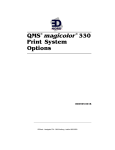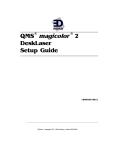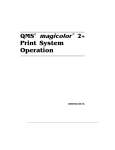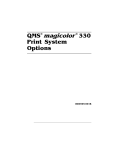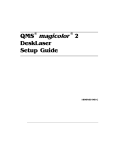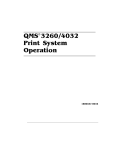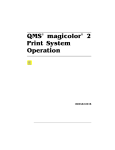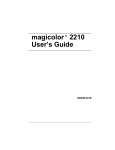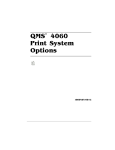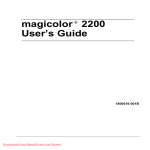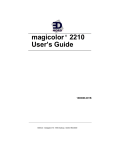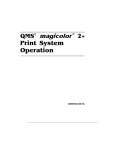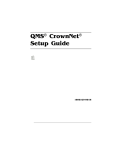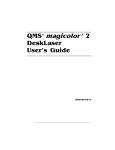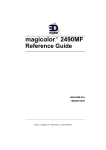Download QMS SC-200 Setup guide
Transcript
® ® EDNord - Istedgade 37A - 9000 Aalborg - telefon 96333500 The following are trademarks or registered trademarks of their respective owners. Other product names mentioned in this manual may also be trademarks or registered trademarks of their respective owners. Registered trademarks are registered in the United States Patent and Trademark Office; some trademarks may also be registered in other countries. QMS, Crown, CrownAdmin, CrownNet, magicolor, the QMS logo, and the Crown seal are registered trademarks of QMS, Inc., and CrownView, ImageServer, PS Executive Series, Q COLOR , and QFORM are trademarks of QMS, Inc. PostScript is a trademark of Adobe Systems Incorporated for a page description language and may be registered in certain jurisdictions. Throughout this manual, “PostScript Level 2” is used to refer to a set of capabilities defined by Adobe Systems for its PostScript Level 2 page description language. These capabilities, among others, are implemented in this product through a QMS-developed emulation that is compatible with Adobe's PostScript Level 2 language. Adobe, Acrobat, the Acrobat logo/Adobe Systems Incorporated. 3Com, 3+Open/3Com Corporation. Aldus, Aldus PageMaker, Aldus FreeHand/Aldus Corporation. Apple, AppleTalk, EtherTalk, LaserWriter, LocalTalk, Macintosh, TrueType/Apple Computer, Inc. VINES/Banyan. Centronics/Centronics. Color Solutions, ColorBlind/Color Solutions. LaserMprints/ Condé Systems. DEC, DECnet, LN03, LN03 Plus, VMS/Digital Equipment Corporation. PhoneNET/ Farallon Computing, Inc. ColorCopyCover/Hammermill. CompuServe/H&R Block. Hewlett-Packard, HP, PCL, HP-GL, LaserJet/Hewlett-Packard Co. IBM, OS/2, Token-Ring/International Business Machines Corporation. Intel/Intel Corporation. Iomega, Jaz, Zip/Iomega. Microsoft, MS-DOS/Microsoft Corporation. NEC, V R4300/NEC. Novell and NetWare/Novell, Inc. QuarkXPress/Quark, Inc. TOPS/Sun Microsystems, Inc. UNIX/UNIX Systems Laboratories. 3M/3M. SIMM/Wang Laboratories. Spectratech/Warren. Cover/ Card/Weyerhaeuser. Ethernet/Xerox. PANTONE Colors generated by the QMS magicolor 2+ are four-color process simulations and may not match PANTONE-identified solid color standards. Use current PANTONE Color Reference Manuals for accurate color. PANTONE Color simulations are only obtainable on this product when driven by qualified Pantone-licensed software packages. Contact Pantone, Inc. for a current list of qualified licensees. PANTONE ® and other Pantone, Inc. trademarks are the proper ty of Pantone, Inc. © Pantone, Inc., 1998. The digitally encoded software included with your QMS magicolor 2+ Print System is Copyrighted © 1999 by QMS, Inc. All Rights Reserved. This software may not be reproduced, modified, displayed, transferred, or copied in any form or in any manner or on any media, in whole or in part, without the express written permission of QMS, Inc. This manual is Copyrighted © 1999 by QMS, Inc., One Magnum Pass, Mobile, AL 36618. All Rights Reserved. This manual may not be copied in whole or in par t, nor transferred to any other media or language, without the express written permission of QMS, Inc. EDNord - Istedgade 37A - 9000 Aalborg - telefon 96333500 Introduction ..................................................................................................... 1-2 About This Manual .......................................................................................... 1-2 Typographic Conventions 1-3 Options ............................................................................................................. 1-4 Introduction ..................................................................................................... 2-2 Antistatic Protection ....................................................................................... 2-2 Single In-Line Memory Modules .................................................................... 2-2 Installation Procedure 2-3 Updating System Software ............................................................................. 2-8 Procedure—PC Users—Network 2-9 EDNord - Istedgade 37A - 9000 Aalborg - telefon 96333500 Procedure—PC Users—Parallel 2-13 Procedure—Macintosh Users 2-14 Introduction ......................................................................................................3-2 Antistatic Protection .......................................................................................3-2 Network and LocalTalk Interfaces .................................................................3-3 What's in an Interface Kit? 3-3 Installation Procedure 3-4 Using a Network Interface 3-6 Using a LocalTalk Interface 3-6 SCSI Interface ..................................................................................................3-7 What's in a SCSI Interface Kit? 3-7 Installation Procedure 3-8 Using a SCSI Interface 3-10 Time-of-Day Clock .........................................................................................3-10 What's in the Kit? 3-10 Installation Procedure 3-11 Introduction ......................................................................................................4-2 Antistatic Protection 4-2 Emulations ......................................................................................................4-3 Downloading an Emulation 4-3 Using an Optional Emulation 4-5 QMS ImageServer ............................................................................................4-5 Disk Fonts ........................................................................................................4-6 Downloading Disk Fonts 4-6 CID Fonts ..........................................................................................................4-8 Kanji Font Internal IDE Hard Disk ..................................................................4-8 EDNord - Istedgade 37A - 9000 Aalborg - telefon 96333500 What's in the Kit? 4-9 Hardware Requirements 4-9 Software Requirements 4-9 Installing a Kanji Font Internal IDE Hard Disk 4-10 Configuring the Printer for Kanji 4-10 QFORM ........................................................................................................... 4-10 ! " Introduction ..................................................................................................... 5-2 Antistatic Protection ....................................................................................... 5-2 Identifying Storage Devices ........................................................................... 5-2 Internal Hard Disks ......................................................................................... 5-3 Installing an Internal Hard Disk 5-3 External Storage Devices ............................................................................... 5-7 Attaching an External Storage Device 5-7 Turning on an External Storage Device 5-7 Using Jaz and Zip Drives 5-8 Formatting a Storage Device ......................................................................... 5-8 Error Messages 5-9 Configuring a Storage Device ........................................................................ 5-9 External Storage Devices 5-9 Internal Hard Disks 5-10 Backing Up Data to a Jaz or Zip Drive ........................................................ 5-10 Error Messages 5-11 Restoring Data from a Jaz or Zip Drive ....................................................... 5-12 Error Messages 5-13 # $ % Introduction ..................................................................................................... 6-2 Additional Media Cassettes ........................................................................... 6-2 Lower Input Feeder ........................................................................................ 6-2 EDNord - Istedgade 37A - 9000 Aalborg - telefon 96333500 What's in the Kit? 6-2 Unpacking the Lower Input Feeder 6-3 Installing the Lower Input Feeder 6-3 Security Key .....................................................................................................6-6 What's in the Kit? 6-6 Setting Configuration Menu Passwords 6-6 Using Configuration Menu Passwords 6-8 BuzzBox ...........................................................................................................6-9 What's in the Kit? 6-9 Installing BuzzBox 6-10 Using BuzzBox 6-11 Color Scanner/Copier ....................................................................................6-12 & '(%% Sources of Support ........................................................................................ A-2 Your QMS Vendor A-2 Your Application Vendor A-2 Internet A-2 QMS Customer Response Center (CRC) A-3 QMS World-wide Offices ................................................................................ A-4 QMS United States and Latin America A-4 QMS Canada A-5 QMS in Japan A-5 QMS EMEA A-5 ) EDNord - Istedgade 37A - 9000 Aalborg - telefon 96333500 * (%+++ “Introduction” on page 1-2 “About This Manual” on page 1-2 “Options” on page 1-4 EDNord - Istedgade 37A - 9000 Aalborg - telefon 96333500 This manual provides detailed instructions for installing your QMS magicolor 2+ Print System options. Use this guide in conjunction with your other printer documentation. &* This manual contains printer configuration and reference information. It is divided into the following sections: Provides an overview of the manual. Introduction Memory and System Software Describes how to install printer memory (SIMMs) and update the system software. Interfaces and Daughterboards Describes how to install network (CrownNet Token-Ring, CrownNet Ethernet and DECnet) and LocalTalk interfaces, a SCSI interface, and a time-of-day clock. Emulations, Fonts, and Other Software Describes how to download fonts and emulations and how to install a Kanji external hard disk. This chapter also provides information about QFORM. Storage Devices Describes how to install and configure hard disks and includes information about storage devices. Hardware Options Describes how to install a lower input feeder, a security key, and a BuzzBox warning buzzer. This chapter also includes information about the optional color scanner/ copier. EDNord - Istedgade 37A - 9000 Aalborg - telefon 96333500 QMS Customer Support Provides world-wide product sales and support telephone numbers and describes how to communicate with QMS through the Internet. Index The following typographic conventions are used in this manual: Mixed-Case Courier Text you type, and messages and information displayed on the screen Mixed-Case Italic Courier Variable text you type; replace the italicized word(s) with information specific to your printer or computer UPPERCASE COURIER Information displayed in the printer message window lowercase bold PostScript operators and DOS commands lowercase italic Variable information in text UPPERCASE File and utility names ↵ Press the Enter key (PC) or Return key (Macintosh) ^ Press and hold down the Ctrl key (PC) In Adobe Acrobat PDF versions of the manual, click to play a QuickTime video clip of the procedure described in the text. EDNord - Istedgade 37A - 9000 Aalborg - telefon 96333500 » Note: Notes contain tips, extra information, or important information that deserves emphasis or reiteration. Caution: Cautions present information that you need to know to avoid equipment damage, process failure, or extreme annoyance. WARNING! Warnings indicate the possibility of personal injury if a specific procedure is not performed exactly as described in the manual. ACHTUNG! Bitte halten Sie sich exakt an die im Handbuch beschriebene Vorgehensweise, da sonst Verletzungsgefahr bestehen könnte. The following options are available for your printer. Contact your local vendor for purchase information. Color Scanner/ Copier See chapter 6, “Hardware Options,” in the Options manual. CrownNet CrownNet Ethernet 10BaseT/100BaseTX CrownNet Token-Ring DECnet-TCP/IP Optional I/O LocalTalk See chapter 3, “Interfaces and Daughterboards,” in the Options manual Emulations, Fonts, and Other Software Emulations Disk Fonts Kanji Font Internal IDE Hard Disk QFORM See chapter 4, “Emulations, Fonts, and Other Software” in the Options manual. EDNord - Istedgade 37A - 9000 Aalborg - telefon 96333500 Interfaces and Daughterboards Network and LocalTalk Interfaces SCSI Interface Time-of-Day Clock See chapter 3, “Interfaces and Daughterboards” in the Options manual. Lower Input Feeder Includes a 250-sheet standard media cassette » Note: The lower input feeder is standard on the EXD model. See chapter 6, “Hardware Options” in the Options manual. Media Cassettes 250-sheet letter/A4 standard media cassette 250-sheet universal cassette (for all supported media sizes) See chapter 6, “Hardware Options,” in the Options manual. Memory See chapter 2, “Memory and System Software” in the Options manual. Security Key System Software See chapter 2, “Memory and System Software” in the Options manual. Security key with a 9-pin connector See chapter 6, “Hardware Options” in the Options manual. If installation instructions are included with the option, follow them. If not, use the installation instructions in this Options manual. EDNord - Istedgade 37A - 9000 Aalborg - telefon 96333500 EDNord - Istedgade 37A - 9000 Aalborg - telefon 96333500 * (% + + + “Introduction” on page 2-2 “Antistatic Protection” on page 2-2 “Single In-Line Memory Modules” on page 2-2 “Updating System Software” on page 2-8 EDNord - Istedgade 37A - 9000 Aalborg - telefon 96333500 This chapter provides details on how to install RAM and how to update system software. & , Caution: It's very important to protect the printer controller board and any associated daughterboard or module from electrostatic damage while performing any task involving the controller board. If an antistatic wrist strap is provided in your printer option kit, attach one end of it to your wrist and the other end to any convenient electrical ground (for example, the bare metal chassis of equipment, as on the back of a computer, that is plugged in but turned off). Never attach the wrist strap to any piece of equipment with an electrical current present. Turn off all power switches first. Plastic, rubber, wood, painted metal surfaces, and telephones are not acceptable grounding points. The printer isn't an acceptable grounding point either because it must be unplugged before you perform this task. If you don't have an antistatic wrist strap, discharge your body's static electric charge by touching a grounded surface before you handle any printer boards or components and before removing the controller board. Also avoid walking around after grounding yourself. -. Single in-line memory modules (or SIMMs) are compact circuit boards with surface-mount memory chips. Your QMS magicolor 2+ Print System comes with the following printer memory: QMS magicolor 2+ CXE Print System—32 MB RAM QMS magicolor 2+ GXE Print System—80 MB RAM QMS magicolor 2+ EXD Print System—192 MB RAM EDNord - Istedgade 37A - 9000 Aalborg - telefon 96333500 However, you can upgrade any of these models to a maximum of 384 MB of RAM through the installation of additional SIMMs. Additional memory allows you to download more fonts and increase the printer's buffer (area where data sent from the computer is stored while waiting to be printed). Caution: You may also need additional memory to print on some media sizes at resolutions above 600x600 dpi. Refer to chapter 4, “Advanced Printing Features,” in the Operation manual for details. Caution: It's very important to protect the printer controller board and SIMM from electrostatic damage. Before performing this procedure, review the antistatic caution in “Antistatic Protection” on page 2-2. Always handle circuit boards by the edges only. 1 In case you need to restore any memory settings after the SIMM installation, print an advanced status page. Note: Installing SIMMs automatically restores defaults. If your memory settings are specific to your environment, print an advanced status page before installing SIMMs, so you can recover the current memory settings. » 2 Turn off the printer, and then disconnect the power cord and all interface cables from the printer. EDNord - Istedgade 37A - 9000 Aalborg - telefon 96333500 3 Remove the printer’s controller board. Loosen two screws, one on each end of the I/O connector panel, and, using the tab on the lower side of the connector panel, pull the controller board from the printer. Note: The illustration shows the printer without the duplexer. However, the instructions are the same for all models. » » 4 Position the controller board on a flat surface so the controller board lies flat and the I/O connector panel is facing you. 5 If you need to remove a SIMM before installing one, remove it as follows; otherwise skip to step 6. Note: If all the SIMM connectors are filled and you want to install more memory, you have to exchange one or more SIMMs for SIMMs with a greater memory capacity. a Using both thumbs, pull the latches (one on each side of the SIMM connector) outward. b Tilt the SIMM backwards to a 45° angle away from the SIMM connector. EDNord - Istedgade 37A - 9000 Aalborg - telefon 96333500 c Lift the SIMM out. .. ............ ............ ............ ............ ............ ............ ............ .. .. .. .. ........ 6 Remove the new SIMM from its antistatic bag. EDNord - Istedgade 37A - 9000 Aalborg - telefon 96333500 7 Insert the new SIMM into the SIMM connector. a » Hold the SIMM at a 45° angle to the controller board, with the notch on the right side and the bottom edge in the connector. Note: The first SIMM must be added to the DRAM0 SIMM connector. Both DRAM0 and DRAM1 must be occupied before adding a third SIMM to DRAM2. ...... ............ ............ ............ ............ ............ ............ ............ ............ EDNord - Istedgade 37A - 9000 Aalborg - telefon 96333500 b Tilt the SIMM up to a 90° angle until you feel it snap into place. When seated, the SIMM stands upright, firmly in place. If you cannot snap the SIMM into place, do not force it. Reposition it, making sure that the bottom of the SIMM is seated completely in the connector. .......... ............ ............ ............ ............ ............ ............ .. .. .. .. ............ 8 Repeat steps 6–7 for each additional SIMM being installed. 9 Reinstall the controller board into the printer. Gently slide the controller board into the printer until it is fully seated, and then tighten the two screws. 10 Reconnect all interface cables. 11 Reconnect the power cord, and turn on the printer. » Note: In compliance with UL guidelines, “The appliance inlet is considered to be the main disconnect device.” EDNord - Istedgade 37A - 9000 Aalborg - telefon 96333500 ! "# 12 Print a startup page. Check that the startup page states the total size of the RAM installed in your printer. 13 If necessary, refer to the advanced status page you printed in step 1 to reconfigure printer memory. /% The system software in your QMS magicolor 2+ Print Systems are stored in flash ROM, read-only memory that can be erased and rewritten to “in a flash.” Updated system software allows you to take advantage of future enhancements to the printer. The use of flash memory for system software storage offers the opportunity for easy field update of system code. A resident loader will be provided to enable the user to install all code updates. Installation of a code update will overwrite the previous contents of the flash memory. EDNord - Istedgade 37A - 9000 Aalborg - telefon 96333500 ! "# —— ! Caution: Do not download system software to an entire group of printers unless every printer in the group is the same model and supports the new software version. If you overwrite a printer’s system software with the wrong type of system software, that printer will not be functional. 1 In the main CrownAdmin window, select the printer, group, or set you want to download to. 2 Read the instructions in your printer documentation for downloading print system software from a PS file. When the instructions say to send the system software to the printer, choose Print File from the File menu in the main CrownAdmin window. 3 In the Print File Dialog Box, use the Browse button to locate and select the system PS file, then choose Open. 4 In the Print File Dialog Box, choose the Print button. ! First, you need to make sure that the printer is up on the network. Before following the instructions below, ensure that your printer is powered on (previous troubleshooting steps may have had you power the printer off). If you have a PC: 1 Go to Start/Programs/MS-DOS Prompt (Start/Programs/Command Prompt for NT). 2 In the DOS window, type: ping ipaddress↵ (for example, ping 161.33.128.5↵) EDNord - Istedgade 37A - 9000 Aalborg - telefon 96333500 ! ! "# If everything is working correctly, you will see output such as: If it doesn't detect the printer on the network, which is usually an incorrect IP address or bad cabling, you will see the following: " EDNord - Istedgade 37A - 9000 Aalborg - telefon 96333500 ! "# If you have the IP scheme set incorrectly on your PC, then you will get the following: 3 If you are running a UNIX box: a Open a window on your UNIX box. b In the window, type: ping ipaddress↵ (for example, ping 161.33.131.62↵) Now that you know it is up on the network, you need to ftp and “put” the system code to the printer. We assume that you have a system file, for example “system.ps” on your hard drive, and that you are in the directory where this file resides. We also assume the printer is in an “idle” state. 1 On a Windows machine, get to a DOS prompt. On a UNIX machine, open a new window and type: ftp ipaddress↵ 2 (for example, ftp 161.33.128.5↵) When prompted for a user name and password, press Enter for both. An ftp> prompt displays. » Note: If a message displays denoting invalid password, contact your system administrator. Otherwise, continue. EDNord - Istedgade 37A - 9000 Aalborg - telefon 96333500 ! "# 3 At the ftp> prompt, change to binary mode by typing bin↵ 4 Now you need to “put” the system file. Type put system.ps↵ The process will look like the following: If a page prints out, then you are communicating correctly. If not, contact the Customer Response Center. 5 At the ftp> prompt, end the ftp session by typing quit↵ 6 Wait 10 minutes, then reboot the printer. Your startup page will reflect the new version of code. EDNord - Istedgade 37A - 9000 Aalborg - telefon 96333500 ! "# —— !" — !!! 1 2 Access the Administration/Miscellaneous/New System Image menu. Menu Administration/Miscellaneous/New System Image Choices Yes—Download new system code No—Don’t download new system code Default No Select Yes in the New System Image menu. The printer automatically reboots and waits for the new system software (image) to be sent via your PC’s parallel port. 3 Send the new system image to the printer. Type copy /b *.dl lpt#↵ where # is 1 to 3. (/b refers to binary files.) Note: In some cases, the extension to the file may be ps. » 4 While the system software is loading, the Online LED blinks off and on, and the message window displays Downloading image via parallel port. 5 After the new system software has been written to ROM, the printer reboots itself to activate the new system software. Note: The new system image doesn’t erase the old image until the printer verifies that the new image is valid. » 6 Print another advanced status page, and verify that the configuration settings are the same. EDNord - Istedgade 37A - 9000 Aalborg - telefon 96333500 ! "# — To upgrade QMS Crown printer system code from a Macintosh, you can download the QMS Printer Utility mentioned below at the QMS web site (ftp://ftp.qms.com/pub/cts/ out_going/mac/prtutil.sea.hqx). If you would like to use an Adobe product, you can download their software at http://www.adobe.com/. 1 Download the latest version of the QMS printer system code. Note: Download only the file the support engineer directs you to download. » 2 Using QMS Printer Utility or Adobe Downloader, send the code to the printer. #$ %! 1 Open the QMS Printer Utility application. 2 Select your printer in the QMS Printer Utility window. 3 Choose Send PostScript File... from the File menu. 4 Choose Browse and locate the file you downloaded from our ftp site. Select the name of the file. 5 Choose Add. 6 Choose Done. 7 Choose Print. & ! 1 Select the printer you wish to upgrade in the Chooser. 2 Open the Adobe Downloader application. 3 Choose Download PostScript File... from the File menu. 4 Locate the file you downloaded from our ftp site. Select the name of the file. EDNord - Istedgade 37A - 9000 Aalborg - telefon 96333500 ! "# 5 Select Open. Caution: Wait 20 minutes, then reboot the printer. The startup page should reflect the new version of code. EDNord - Istedgade 37A - 9000 Aalborg - telefon 96333500 EDNord - Istedgade 37A - 9000 Aalborg - telefon 96333500 * (%+++ “Introduction” on page 3-2 “Antistatic Protection” on page 3-2 “Network and LocalTalk Interfaces” on page 3-3 “SCSI Interface” on page 3-7 “Time-of-Day Clock” on page 3-10 EDNord - Istedgade 37A - 9000 Aalborg - telefon 96333500 The following options mount on your printer’s controller board: Network interfaces (CrownNet Ethernet, CrownNet Token-Ring, and Crown for DECnet-TCP/IP) LocalTalk interface SCSI interface Time-of-day clock & , Caution: It’s very important to protect the printer controller board and any associated daughterboard or module from electrostatic damage while performing any task involving the controller board. If an antistatic wrist strap is provided in your printer option kit, attach one end of it to your wrist and the other end to any convenient electrical ground (for example, the bare metal chassis of equipment, as on the back of a computer, that is plugged in but turned off). Never attach the wrist strap to any piece of equipment with an electrical current present. Turn off all power switches first. Plastic, rubber, wood, painted metal surfaces, and telephones are not acceptable grounding points. The printer isn’t an acceptable grounding point either because it must be unplugged before you perform this task. If you don’t have an antistatic wrist strap, discharge your body’s static electric charge by touching a grounded surface before you handle any printer boards or components and before removing the controller board. Also avoid walking around after grounding yourself. EDNord - Istedgade 37A - 9000 Aalborg - telefon 96333500 $#% %" 01.*1 Your printer supports the following interface cards: CrownNet Ethernet 10BaseT/100BaseTX (TCP/IP, NetWare, Ethertalk, LAN Manager/LAN Server) for an additional CrownNet Ethernet connection CrownNet Token-Ring (TCP/IP, NetWare, LAN Manager/LAN Server) QMS Crown for DECnet-TCP/IP LocalTalk You can install one of these interface cards in addition to the three standard interfaces—parallel, serial, and CrownNet Ethernet (TCP/IP, NetWare, Ethertalk, LAN Manager/LAN Server). The printer’s Simultaneous Interface Operation (SIO) allows all of these interfaces to be active at the same time. In other words, your printer can simultaneously communicate through all four ports with four hosts, either computers or networks. An optional interface kit includes the following: » An interface card Interface documentation (in hardcopy and/or on CD-ROM) Note: If you ordered a LocalTalk interface, all of the documentation you need is included in the Operation manual and this manual. The kit may also include additional parts not required for network interface installation on this printer. #$%& EDNord - Istedgade 37A - 9000 Aalborg - telefon 96333500 $#% %" Caution: It’s very important to protect the printer controller board and any associated circuit boards from electrostatic damage. Before performing this procedure, review the antistatic caution in “Antistatic Protection” on page 3-2. In addition, always handle circuit boards by the edges only. 1 Note: The illustration shows the printer without the duplexer. However, the instructions are the same for all models. » 2 Turn off the printer, and then disconnect the power cord and all interface cables from the printer. Loosen two screws (one on each end of the interface panel) and, using the tab on the lower side of the panel, pull the controller board from the printer. EDNord - Istedgade 37A - 9000 Aalborg - telefon 96333500 $#% %" 3 Remove the two screws holding the metal plate over the optional interface opening. The optional interface opening is labelled “Option.” It’s located next to the “Parallel” port. Save the two screws. (You’ll use them when you install the optional interface card.) You can discard the plate. 4 ◆ Attach the interface card to the controller board. a Position the interface card so that its I/O connector slides into its opening in the interface panel and that its 80-pin connector aligns with the 80-pin connector on the controller board. b Gently press the interface card down until its connector is fully seated and the card is secured by the plastic support post(s). Caution: Make sure that the connectors on the interface card and controller board are properly aligned. Damage to the interface card and/or controller board could result if the pins are misaligned. .......... ............ ............ ............ ............ ............ ............ .. .. .. .. ............ #$%& EDNord - Istedgade 37A - 9000 Aalborg - telefon 96333500 $#% %" 5 Secure the interface card to the interface panel with the two screws you removed earlier. 6 Reinstall the controller board. Gently slide the controller board into the printer until it is fully seated, and then tighten the two screws. 7 Reconnect all interface cables. 8 Reconnect the power cord, and turn on the printer. Note: In compliance with UL guidelines, “The appliance inlet is considered to be the main disconnect device.” » 9 Print a startup page. Check that the startup page lists the interface (Optional NIC) just installed under “Options.” Once a network interface is installed, refer to the following for more information: For a CrownNet interface, refer to the Connecting Your QMS Print System for information on connecting to the network, installing the software, and configuring the interface and the network. In addition, chapter 2, “Printer Configuration,” of QMS CrownNet Interface System Administrator’s Guide, provides complete configuration information. For a DECnet-TCP/IP interface, refer to the QMS DECnet-TCP/IP Setup Guide and the TCP/IP Protocol Option User’s Guide. Your application and network documentation contain information on printing over the network. ! Once a LocalTalk interface is installed, refer to the following for more information: For configuration information, refer to chapter 4, “Printer Configuration,” in the Reference manual. Your application and Macintosh documentation contain information on printing via LocalTalk. EDNord - Istedgade 37A - 9000 Aalborg - telefon 96333500 " ( The optional SCSI interface allows you to connect up to three optional SCSI devices, including hard disks, and Jaz and Zip drives. These devices provide storage for fonts, emulations, and other files; increase the number of pages that can be collated; and provide a secondary storage area for spooled data, while providing virtual memory capabilities. "" An optional SCSI interface kit includes the following: SCSI interface card SCSI interface card ribbon cable Connector face plate Two larger screws Two smaller screws #$%& EDNord - Istedgade 37A - 9000 Aalborg - telefon 96333500 " Caution: It’s very important to protect the printer controller board and any associated circuit boards from electrostatic damage. Before performing this procedure, review the antistatic caution in “Antistatic Protection” on page 3-2. In addition, always handle circuit boards by the edges only. 1 Note: The illustration shows the printer without the duplexer. However, the instructions are the same for all models. » 2 Turn off the printer, and then disconnect the power cord and all interface cables from the printer. Loosen two screws (one on each end of the interface panel) and, using the tab on the lower side of the panel, pull the controller board from the printer. EDNord - Istedgade 37A - 9000 Aalborg - telefon 96333500 " 3 Remove the two screws holding the metal plate over the SCSI interface opening. The SCSI interface opening is labelled “SCSI.” It’s located next to the “Serial” and “Key” ports. You can discard the metal plate and screws. 4 Attach the ribbon cable to its connector on the SCSI interface card. ... .... .. .... .... .... .... ............ .. ............ ............ ............ ............ ............ ............ ............ .. .. .. .. ........ ... .... .. .... .... .... .... ............ 5 ◆ Attach the SCSI interface card to the controller board. a Position the SCSI interface card so that its ribbon cable connector aligns with the SCSI connector on the controller board. b Gently press the ribbon cable connector down until it’s fully seated. Caution: Make sure that the connectors on the ribbon cable and the controller board are properly aligned. Damage to the controller board could result if the pins are misaligned. #$%& EDNord - Istedgade 37A - 9000 Aalborg - telefon 96333500 ! "& % 6 c Insert the SCSI interface card connector into its opening in the interface panel. d Secure the SCSI interface card to the interface panel with the two larger screws in the kit. Reinstall the controller board. Gently slide the controller board into the printer until it’s fully seated, and then tighten the two screws. 7 Reconnect all interface cables. 8 Reconnect the power cord and turn on the printer. Note: In compliance with UL guidelines, “The appliance inlet is considered to be the main disconnect device.” » 9 Print a startup page. Check that the startup page lists the interface (SCSI) just installed under “Options.” "" » Note: Installing the SCSI interface kit alone will not allow you to print via SCSI. See chapter 5, “Storage Devices” for further information about attaching Jaz or Zip drives. * --(1 The time-of-day clock provides time and date information on the startup page and in the accounting data. The optional time-of-day clock kit includes only the following: " Time-of-day clock EDNord - Istedgade 37A - 9000 Aalborg - telefon 96333500 "& % Caution: It’s very important to protect the printer controller board and any associated circuit boards from electrostatic damage. Before performing this procedure, review the antistatic caution in “Antistatic Protection” on page 3-2. In addition, always handle circuit boards by the edges only. 1 Turn off the printer, and then disconnect the power cord and all interface cables from the printer. 2 Loosen two screws (one on each end of the interface panel) and, using the tab on the lower side of the panel, pull the controller board from the printer. Note: The illustration shows the printer without the duplexer. However, the instructions are the same for all models. » 3 Attach the time-of-day clock to the controller board. WARNING: Because the time-of-day clock includes an internal battery, there is a danger of explosion if the clock is incorrectly installed or replaced. Replace it only with a supported QMS time-of-day clock. Dispose of any used time-of-day clock in accordance with local laws and regulations. ACHTUNG! Da der Uhrenbaustein eine interne Batterie enthält, besteht Explosionsgefahr, falls dieser falsch eingesetzt oder ersetzt wird. Er darf nur durch einen unterstützten Baustein ersetzt werden. Bitte entsorgen Sie den Baustein gemäß den geltenden Entsorgungsbestimmungen. AVERTISSEMENT! Dû au fait que l’horloge interne de l’imprimante est munie d’une batterie interne, il y a un risque d’explosion si celle-ci est mal installée ou remplacée. La remplacer seulement avec une horloge supportée par QMS. Se départir de toute horloge interne défectueuse en respectant les lois et réglementations en vigueur. #$%& EDNord - Istedgade 37A - 9000 Aalborg - telefon 96333500 "& % a b Locate the time-of-day clock socket on the controller board and the pin 1 notch or printed label. Locate the pin 1 indicator mark on the top of the time-of-day clock. This mark may be a notch or a slight depression on one end of the clock. ◆ ...... ............ ............ ............ ............ ............ ............ ............ .. .. .. .. .... c Align this indicator mark with the pin 1 notch or printed label on the controller board. d Gently press down on the time-of-day clock until it’s firmly seated. Caution: Make sure that the pins on the time-of-day clock are properly aligned with those in the receiving socket on the controller board. Damage to the time-of-day clock and/or controller board could result if the pins are misaligned. 4 Reinstall the controller board. Gently slide the controller board into the printer until it is fully seated, and then tighten the two screws. 5 Reconnect all interface cables. 6 Reconnect the power cord and turn on the printer. Note: In compliance with UL guidelines, “The appliance inlet is considered to be the main disconnect device.” » 7 Print a startup page. The time-of-day clock is not listed under “Installed Options” on the startup page, but the time will appear as System Date in the Printer Information column. EDNord - Istedgade 37A - 9000 Aalborg - telefon 96333500 * (%+++ “Introduction” on page 4-2 “Emulations” on page 4-3 “QMS ImageServer” on page 4-5 “Disk Fonts” on page 4-6 “CID Fonts” on page 4-8 “Kanji Font Internal IDE Hard Disk” on page 4-8 “QFORM” on page 4-10 EDNord - Istedgade 37A - 9000 Aalborg - telefon 96333500 Your printer has several software options which expand its capabilities: QMS emulations QMS ImageServer Disk fonts CID fonts QMS Kanji font internal hard disks QMS QFORM # Caution: It’s very important to protect the printer controller board and any associated daughterboard or module from electrostatic damage while performing any task involving the controller board. If an antistatic wrist strap is provided in your printer option kit, attach one end of it to your wrist and the other end to any convenient electrical ground (for example, the bare metal chassis of equipment, as on the back of a computer, that is plugged in but turned off). Never attach the wrist strap to any piece of equipment with an electrical current present. Turn off all power switches first. Plastic, rubber, wood, painted metal surfaces, and telephones are not acceptable grounding points. The printer isn’t an acceptable grounding point either because it must be unplugged before you perform this task. If you don’t have an antistatic wrist strap, discharge your body’s static electric charge by touching a grounded surface before you handle any printer boards or components and before removing the controller board. Also avoid walking around after grounding yourself. EDNord - Istedgade 37A - 9000 Aalborg - telefon 96333500 '( Optional emulations, such as CGM, LN03 Plus, and XES/UDK, are available as PostScript files on floppy disks. This section describes how to download an optional emulation to the printer’s hard disk. » Note: You must have at least one hard disk, internal or external, attached to the printer in order to use an optional emulation. If more than one hard disk is available, the emulation automatically installs itself on the disk with the most free storage space. QMS recommends that you have at least 4 MB of memory above the base configuration and that you add at least 1 MB memory to each emulation installed. This ensures that the printer can run the emulation without slowing down performance. $%& ' We recommend that you use CrownAdmin to download an emulation. Refer to the CrownAdmin online help for instructions. ' ! !!!( " 1 Turn on the printer, and wait for IDLE to appear in the message window. 2 Insert the emulation disk in your PC’s 3.5" disk drive, and change to that drive (for example, if you’re using the A drive, type a:↵). 3 Send the emulation to the printer’s hard disk. If your PC and printer are connected through the parallel port, type copy /b *.ps lpt#↵ where # is 1 to 3. (/b refers to binary files.) If your PC and printer are connected through the serial port, type copy /b *.ps com#↵ where # is 1 to 4. (/b refers to binary files.) '( )*)% EDNord - Istedgade 37A - 9000 Aalborg - telefon 96333500 '( 4 When downloading is complete, reboot the printer. The emulation should be listed in the Options section of the printer’s startup page, in the Administration/Emulation printer’s configuration menu, and on the advanced status page. ') ( " » Note: Before you begin this procedure, your printer and PC (or UNIX workstation) must be connected to an Ethernet network running TCP/IP and have valid IP addresses. 1 If your PC is running Windows, change to DOS. 2 Insert the emulation disk in your PC’s 3.5" disk drive, and change to that drive (for example, if you’re using the A drive, type a:↵). 3 If you want to download the emulation from a UNIX workstation, copy the installation file from the emulation disk to a temporary directory on your UNIX workstation. 4 Turn on the printer, and wait for IDLE to appear in the message window. 5 Open an ftp session at your PC or workstation by typing one of the following commands: ftp printername↵ ftp ipaddress↵ 6 (for example, ftp pctdev6↵) (for example, ftp 161.33.130.45↵) When prompted for a user name and password, press Enter for both. An ftp> prompt displays. 7 At the ftp> prompt, change to binary mode by typing bin↵ 8 At the ftp> prompt, send the emulation file to the printer’s hard disk by typing put filename.ps↵ where filename is the name of the installation file. The printer’s message window reads 1 Active Job to indicate that the emulation is being downloaded to the hard disk. The ftp> prompt returns when the emulation has finished loading. EDNord - Istedgade 37A - 9000 Aalborg - telefon 96333500 $+ 9 At the ftp> prompt, end the ftp session by typing quit↵ 10 When the Disk light stops flashing and the printer’s message window reads Idle for at least 30 seconds, turn the printer off and then on again. 11 When the printer’s message window reads Idle again, the emulation is ready to use. The emulation should be listed in the Options section of the printer’s startup page, in the Administration/Emulation printer’s configuration menu, and on the advanced status page. » Note: You may want to erase any installation files left on your computer (and/or workstation), and then remove any temporary directories. '%& Use the Administration/Emulation menu to set the parameters for the available printer emulations. Optional emulations appear only if installed. Refer to the documentation that came with your emulation for configuration and usage instructions. » Note: To choose an emulation for a particular interface, use the appropriate interface menu in the Administration/Communications menu. The QMS ImageServer option includes products that raise image printing performance and enhance print functionality to a level comparable to that of the document imaging system as a whole. Typically, print performance in a non-ImageServer environment is realtively slow due to the nature of raster file formats and the lack of attention given to print system enabling within the imaging system. ImageServer option products specifically address these limitations and adapt QMS printer products to the document imaging system. Optional emulations such as the QMS ImageServer are available as PostScript files on floppy disks for your computer. When an emulation has been downloaded for the printer’s hard disk and the printer has been rebooted, the emulation will show up on the printer status page and the con'( )*)% EDNord - Istedgade 37A - 9000 Aalborg - telefon 96333500 # ,* figuration menu. For complete information about the emulation’s configuration options for CALS and TIFF, refer to the documentation that comes with the ImageServer option. 1 Optional fonts are available as PostScript files on floppy disks. This section describes how to download optional fonts from a floppy disk to the printer’s hard disk. » Note: At least one hard disk (internal or external) must be present on your printer before you can download a font. If more than one hard disk is available, the font automatically installs itself on the disk with the most free storage space. ' We recommend that you use CrownAdmin to download fonts. Refer to the CrownAdmin online help for instructions. ' ! !!!( " This procedure contains the instructions for downloading the fonts from a floppy disk onto your printer’s hard disk. 1 Connect the PC to the printer’s parallel or serial port. 2 Turn on the printer, and wait for IDLE to appear in the message window. 3 Insert the font disk in your PC’s 3.5" disk drive, and change to that drive (for example, if you’re using the A drive, type a:↵). 4 Send the fonts to the printer’s hard disk. If your PC and printer are connected through the parallel port, type copy /b *.ps lpt#↵ where # is 1 to 3. (/b refers to binary files.) EDNord - Istedgade 37A - 9000 Aalborg - telefon 96333500 # ,* If your PC and printer are connected through the serial port, type copy /b *.ps com#↵ where # is 1 to 4. (/b refers to binary files.) 5 When the downloading is complete, reboot the printer. ') ( " » Note: Before you begin this procedure, your printer and PC (or UNIX workstation) must be connected to an Ethernet network running TCP/IP and have valid IP addresses. 1 If your PC is running Windows, change to DOS. 2 Insert the fonts disk in your PC’s 3.5" disk drive, and change to that drive (for example, if you’re using the A drive, type a:↵). 3 If you want to download the fonts from a UNIX workstation, copy the installation file from the fonts disk to a temporary directory on your UNIX workstation. 4 Turn on the printer, and wait for IDLE to appear in the message window. 5 Open an ftp session at your PC or workstation by typing one of the following commands: ftp printername↵ ftp ipaddress↵ 6 (for example, ftp pctdev6↵) (for example, ftp 161.33.130.45↵) When prompted for a user name and password, press Enter for both. An ftp> prompt displays. 7 At the ftp> prompt, change to binary mode by typing bin↵ 8 At the ftp> prompt, send the fonts file to the printer’s hard disk by typing put filename.ps↵ where filename is the name of the installation file. The printer’s message window reads 1 Active Job to indicate that the fonts are being downloaded to the hard disk. The ftp> prompt returns when the fonts have finished loading. '( )*)% EDNord - Istedgade 37A - 9000 Aalborg - telefon 96333500 -#* 9 At the ftp> prompt, end the ftp session by typing quit↵ 10 When the Disk light stops flashing and the printer’s message window reads Idle for at least 30 seconds, turn the printer off and then on again. 11 When the printer’s message window reads Idle again, the fonts are ready to use. The fonts should be listed in the Options section of the printer’s startup page, in the Administration/PCL 5E printer’s configuration menu, and on the advanced status page. » Note: You may want to erase any installation files left on your computer (and/or workstation), and then remove any temporary directories. CID fonts are supported on the magicolor 2+. CID fonts are a format of composite (multibyte) Type 1 fonts that address the requirements of Far East markets. CID-keyed refers to the character identifier (CID) numbers that are used to index and access the characters in the font. A CID font consists of a large font file that contains all the character outlines and a small CMap file that contains a list of characters, encodings, and character identifiers. Each CID font can support many character set and encoding combinations. 23 $ 1 The preformatted QMS Kanji font internal IDE hard disk contains Kanji fonts and other files. These fonts can be printed at a variety of point sizes and in different styles and resolutions. After the Kanji hard disk is installed in your QMS magicolor 2+, the Kanji fonts are available for use just as if they were resident in the printer. EDNord - Istedgade 37A - 9000 Aalborg - telefon 96333500 ./ *( #'0# , Internal hard disk preformatted with the following Kanji fonts: – FutoGoB101-Bold – FutoMinA101-Bold – Jun101-Light – MidashiGo-MB31 – MidashiMin-MA 31 IDE hard disk with ribbon cable attached IDE hard disk bracket 3 screws For assistance or information, call your local vendor. See appendix A, “QMS Customer Support,” for locations and telephone numbers. ()*& A Macintosh, IBM PC, or compatible computer ")*& An application (such as a word processing or desktop publishing package) that supports the PostScript printing. If you’re using a Macintosh, the following Macintosh system software: – KanjiTalk, version J1-6.0.7 or later – System File, version J1-6.0.7 or later – Laser Prep, version J1-6.0.1 or later – LaserWriter, version J1-6.0.2 or later – Print Monitor, version J1-1.3 or later – MultiFinder, version J1-6.1.7 or later – Macintosh OS 8.xJ '( )*)% EDNord - Istedgade 37A - 9000 Aalborg - telefon 96333500 ! *1 If you’re using a PC, the following system software: – If you’re using Windows, version 3.1J or later – If you’re using DOS, version 5.0J or later +,$%($ Caution: The Kanji fonts are factory installed on a formatted hard disk drive. DO NOT reformat or initialize the QMS Kanji internal hard disk. Reformatting erases all data, fonts, and files on the disk. Your warranty does not cover this error. The Kanji font internal IDE hard disk is installed on the controller board in the same way any internal hard disk is installed. See chapter 5, “Storage Devices,” for detailed steps on installing an internal hard disk. Caution: If you already have a hard disk, you need to retrieve the fonts and forms and system code and place them on a new hard disk. If you already have an internal hard disk installed, you must remove it before you can install the Kanji disk. + See chapter 5, “Storage Devices,” for information on how to configure your printer’s memory when using an internal hard disk. ' 4 The QMS QFORM option allows you to use existing lineprinter and forms printing applications on your QMS magicolor 2+ Print System. This printer resident application gives you the ability to store PostScript forms on the printer’s hard disk and fill those forms with your application’s ASCII print stream. Features include " Definition of page formatting and fonts Duplexing with binding-margin offsets Two-sided forms with text fill-in on front and/or back EDNord - Istedgade 37A - 9000 Aalborg - telefon 96333500 *1 » “Greenbar” listing formats Automatic page numbering ANSI carriage-control recognition Single- and multipart forms Labels and multipart forms Logos and watermarks Note: QMS QFORM doesn’t support color features. Refer to the documentation that comes in the QFORM kit for installation and usage instructions. '( )*)% EDNord - Istedgade 37A - 9000 Aalborg - telefon 96333500 EDNord - Istedgade 37A - 9000 Aalborg - telefon 96333500 * (% + + + “Introduction” on page 5-2 “Antistatic Protection” on page 5-2 “Identifying Storage Devices” on page 5-2 “Internal Hard Disks” on page 5-3 “External Storage Devices” on page 5-7 “Formatting a Storage Device” on page 5-8 “Configuring a Storage Device” on page 5-9 “Backing Up Data to a Jaz or Zip Drive” on page 5-10 “Restoring Data from a Jaz or Zip Drive” on page 5-12 EDNord - Istedgade 37A - 9000 Aalborg - telefon 96333500 Hard disks, Jaz drives, and Zip drives provide storage for character bitmaps, downloaded outline fonts, and other files. Hard disks also provide virtual memory. This chapter provides information on installing and using internal and external hard disks as well as Iomega Jaz and Zip drives. & , Caution: It’s very important to protect the printer controller board and any associated daughterboard or module from electrostatic damage while performing any task involving the controller board. If an antistatic wrist strap is provided in your printer option kit, attach one end of it to your wrist and the other end to any convenient electrical ground (for example, the bare metal chassis of equipment, as on the back of a computer, that is plugged in but turned off). Never attach the wrist strap to any piece of equipment with an electrical current present. Turn off all power switches first. Plastic, rubber, wood, painted metal surfaces, and telephones are not acceptable grounding points. The printer isn’t an acceptable grounding point either because it must be unplugged before you perform this task. If you don’t have an antistatic wrist strap, discharge your body’s static electric charge by touching a grounded surface before you handle any printer boards or components and before removing the controller board. Also avoid walking around after grounding yourself. " Hard disks, Jaz drives, and Zip drives are identified by their device numbers. If the printer has an internal hard disk, it has a device number of DSK7. If optional external hard disks and/or drives are attached, their device numbers can be DSK0–DSK4 or DSK6. Device numbers of external hard disks and drives can be set by the installer. EDNord - Istedgade 37A - 9000 Aalborg - telefon 96333500 '& % » Note: If an internal hard disk is removed or an external hard disk or drive is not turned on, the printer does not reset nonvolatile RAM to the factory defaults. Caution: If you connect to this printer an external hard disk you previously used with an earlier QMS Crown printer (such as a QMS 2060, 4060, or magicolor 2, or magicolor 330), this QMS magicolor 2+ Print System software release will automatically reorganize the files on the hard disk when the printer is turned back on again. (The printer release number is listed on both the startup and the status page.) Once this reorganization is done, the files on the hard disk can no longer be accessed if the hard disk is reattached to an earlier QMS Crown printer. This reorganization process takes time. If, when you first turn the printer on after attaching a previously used hard disk, it does not come on line immediately, be patient. Interrupting the reorganization process could cause all files on the hard disk to be lost. $ 1 Only one internal IDE hard disk is supported. However, you can add up to three external SCSI hard disks, Jaz drives, and/or Zip drives to the printer. ($ *’+, The IDE hard disk kit includes the following: IDE hard disk with ribbon cable attached IDE hard disk bracket 3 screws $#+ EDNord - Istedgade 37A - 9000 Aalborg - telefon 96333500 '& % (!! - Caution: It's very important to protect the printer controller board and any associated circuit boards from electrostatic damage. Before performing this procedure, review the antistatic caution in “Antistatic Protection” on page 5-2. In addition, always handle circuit boards by the edges only. When installing or removing a hard disk, ensure that the metal support posts (on the hard disk) don’t hit any of the electrical leads on the chips mounted on the controller board. The controller board will not function if any of the leads are broken or shorted together. 1 Note: The illustration shows the printer without the duplexer. However, the instructions are the same for all models. » Turn off the printer, and then disconnect the power cord and all interface cables from the printer. 2 Loosen two screws (one on each end of the interface panel) and, using the tab on the lower side of the panel, pull the controller board from the printer. 3 Position the controller board on a flat surface so the controller board lies flat and the interface panel is facing you. EDNord - Istedgade 37A - 9000 Aalborg - telefon 96333500 '& % 4 If you need to remove a hard disk before installing one, remove it as follows; otherwise skip to step 5. a Place your left hand on the metal interface plate, the thumb on your right hand on top of the hard disk, and the other fingers on your right hand underneath the corner of the hard disk, and then pull up gently but firmly on the hard disk. The disk is firmly seated, so it may take several tries to remove it. ...... ............ ............ ............ ............ ............ ............ .. .. .. ...... ............ b Unplug the ribbon cable connector from its mating connector on the controller board. Caution: Don’t push or pull with the ribbon cable. Use the cable connector. $#+ EDNord - Istedgade 37A - 9000 Aalborg - telefon 96333500 '& % 5 Attach the IDE hard disk to the hard disk bracket. Attach the IDE hard disk to the bracket with the grooved-end of the bracket facing the ribbon cable. The screw holes in the bottom of the hard disk should match up with the holes on the hard disk bracket. Fasten the hard disk to the bracket with the screws provided. .......... ............ ............ ............ ............ ............ .. .. .. .. ............ ............ 6 Position the hard disk so that the four support posts face the controller board, the colored stripe on the ribbon cable faces away from you, and the connector is down. 7 Insert ribbon cable connector pin 1 (the colored stripe side of the cable) in hard disk connector pin 1. Caution: Make sure that the ribbon cable connector and the controller board connector pins are properly aligned. Damage to the controller board could result if the pins are misaligned. 8 Press down gently but firmly on the cable connector until it is fully seated. Caution: Do not push or pull with the ribbon cable. Use the cable connector. 9 Align the support posts with the holes on the controller board, and then press down to secure the hard disk to the controller board. So that you don’t stress the board, press one corner at a time to secure the hard disk to the controller board. EDNord - Istedgade 37A - 9000 Aalborg - telefon 96333500 10 Reconnect all interface cables. 11 Reconnect the power cord and turn on the printer. » Note: In compliance with UL guidelines, “The appliance inlet is considered to be the main disconnect device.” 12 Print a startup page. Check that the startup page indicates the presence of the hard disk. » Note: You must have an optional SCSI interface board installed before you can attach an external SCSI hard disk, Jaz drive, or Zip drive. Refer to the installation instructions in chapter 3, “Interfaces and Daughterboards.” For information on attaching an external SCSI hard disk, an Iomega Jaz drive, or an Iomega Zip drive, see the documentation that comes with the device. See FAQ 7181 for a list of each QMS-approved hard disk, its manufacturers and part numbers, and the QMS products on which it can be used. You can access QMS FAQs through the Internet at http://www.qms.com/support, then click on FAQs (see appendix A, “QMS Customer Support”). » Note: FAQ numbers may be subject to change, so you may want to obtain a directory of FAQs before requesting a specific document. For the printer to recognize one or more external storage devices, each device must be turned on before you turn on the printer. If the printer recognizes the device(s) and the startup page is enabled, check to ensure that DISK ONLINE prints on that page. If the startup page is not enabled, print a status page and check to see if DISK ONLINE prints on that page. If DISK ONLINE does not print, see chapter 9, “Troubleshooting Printer Problems,” of the Operation manual for more information. EDNord - Istedgade 37A - 9000 Aalborg - telefon 96333500 * & Properly installed devices also appear in the “Options” section of the startup page (if it’s enabled) and on the status page as %%diskx%. (x is a 7 for an internal IDE hard disk and 0-4 or 6 for any external SCSI hard disks or drives, depending on the SCSI ID set on the back of the device.) ./0$ Keep the following in mind when using Jaz and Zip drives: Data can be backed up only to Jaz and Zip drives, not to external SCSI hard disks. Jaz and Zip drive information shows up on the startup and status page only if media is present in the drive. If a Jaz or Zip drive is attached to the printer but no media is present, you will experience a long delay (30 seconds or more) when you take the printer off line and put it back on line. Jaz and Zip drives cannot be used for disk swapping or accounting. They can be used only for font and file storage and for data backup and restoration. " Access the Administration/Disk Operations menu, and then press the control panel keys in the order shown in the following table. The printer responds by displaying a status message in the message window (DSK refers to the device, and # is the device number). » Note: You may need to press the Next key one or more times to advance through the list of selections or options. Press this key... to... and the message window reads... Select Access the Disk Operations/Format Disk menu FORMAT DISK Select Access the Format Disk/Dsk#: menu. DSK#: Next or Previous Advance through the list of attached devices. DSK#: Select Select the device and display a format confirmation message. ARE YOU SURE? EDNord - Istedgade 37A - 9000 Aalborg - telefon 96333500 " & Press this key... to... and the message window reads... Select Begin the formatting process. While the system FORMATTING... reboots, the device is being formatted. Notify you when the formatting process is complete. The printer then powers up, and a startup page prints (if enabled). FORMAT COMPLETE % The following error messages may appear while you are using the Disk Operations menu: Message Meaning Action FORMAT FAILED The device cannot be used. Press the Menu key to remove the message, and contact your local vendor. WRITE ERROR The device encountered a write error, or there is no room for the data on the device or in RAM. Press the Menu key to remove the message, and restart the operation from the beginning. ( " » Note: While you’re making changes in the configuration menu, you may also want to turn on the printer’s page recovery option. (Choose On in the Administration/Engine/ Page Recovery menu.) Page recovery allows the printer to automatically track and reprint jammed pages so you don’t have to resend jobs after clearing a jam. %-"$ 1 Use the Administration/Memory/Manual Config/K Mem Disc Cache menu to increase the disk cache size to 1256 KB. 2 Turn the printer off and then on again. 3 Print a status page to check that the Disk Cache size is increased. (Notice that VM remaining memory is also increased.) $#+ EDNord - Istedgade 37A - 9000 Aalborg - telefon 96333500 ! +% !& ,-. & ($ 1 Use the Administration/Memory/Enable Disk Swap menu to enable disk swapping. Disk swapping takes full advantage of the disk by allowing the printer to use the hard disk to supplement RAM when necessary. 2 Turn the printer off and then on again to make this change take effect. 51 /%678 % " » Note: If a Jaz drive is formatted and the user wants to back up immediately after that, the printer needs to be taken online first after the format before a backup can be performed. Attach the Jaz or Zip drive to which you’ll be backing up data to the printer’s SCSI port or SCSI chain. » Note: You cannot back up data to an internal or external hard disk. Access the Administration/Disk Operations menu, and then press the control panel keys in the order shown in the following table. The printer responds by displaying a status message in the message window (DSK refers to the device, and # is the device number). » " Note: You may need to press the Next key one or more times to advance through the list of selections or options. Press this key... to... and the message window reads... Next Advance to the Disk Operations/Backup Hard Disk menu DISK OPERATIONS BACKUP HARD DISK Select Access the Backup Hard Disk/Dsk#: menu. BACKUP HARD DISK DSK#x Next or Previous Advance through the list of attached devices. BACKUP HARD DISK DSK#x Select Access the DSK#x/Full menu. DSK#x FULL EDNord - Istedgade 37A - 9000 Aalborg - telefon 96333500 +% !& ,-. & Press this key... to... and the message window reads... Next (optional) Access the DSK#x/Incremental menu. DSK#x INCREMENTAL Select Begin the backup process. The printer creates a COPYING DATA Backup directory on the Jaz or Zip drive to which you’re backing data up and stores the data in that directory. If the drive has not already been formatted, the printer automatically formats it. If the drive already has a Backup directory, the new backed up data overwrites the data in that directory. If the backup requires more than one Jaz or Zip INSERT MEDIA x drive, the message display prompts you. Be (x is the disk number) sure to number the drives since the restore process requires you to use them in the proper sequence. You’re prompted when the backup process has BACKUP COMPLETE finished. Menu (several times) Exit from the configuration menu. CONFIGURATION ADMINISTRATION Online Put the printer back on line. IDLE % The following error messages may appear while you are using the Disk Operations menu: Message Meaning Action DISK ERROR The device cannot perform a Press the Online key to take the backup correctly immediately printer online before a backup can be after formatting a Jaz drive. performed. WRITE PROTECT The drive is write-protected. Remove the drive’s write protection. $#+ EDNord - Istedgade 37A - 9000 Aalborg - telefon 96333500 / &" ,-. & 4 678 % " Attach the Jaz or Zip drive from which you’ll be restoring data to the printer’s SCSI port or SCSI chain. Then access the Administration/Disk Operations menu, and then press the control panel keys in the order shown in the following table. The printer responds by displaying a status message in the message window (DSK refers to the device, and # is the device number). » Note: You may need to press the Next key one or more times to advance through the list of selections or options. Press this key... to... and the message window reads... Next Advance to the Disk Operations/ Restore Disk menu DISK OPERATIONS RESTORE DISK Select Access the Restore Disk/Dsk#: menu. RESTORE DISK DSK#x Next or Previous Advance through the list of attached devices. RESTORE DISK DSK#x Select Begin the restore process. COPYING DATA If the original backup required more than one Jaz or Zip drive, the message display prompts you. Be sure to insert the drives in the proper sequence. INSERT MEDIA x (x is the disk number) You’re prompted when the backup process has RESTORE COMPLETE finished. Menu (several times) Exit from the configuration menu. CONFIGURATION ADMINISTRATION Online Put the printer back on line. IDLE EDNord - Istedgade 37A - 9000 Aalborg - telefon 96333500 / &" ,-. & % The following error message may appear while you’re using the Disk Operations menu: Message Meaning Action SEQUENTIAL ERROR The backup drives have been Remove the drive and insert the inserted in the wrong correct one. sequence. $#+ EDNord - Istedgade 37A - 9000 Aalborg - telefon 96333500 EDNord - Istedgade 37A - 9000 Aalborg - telefon 96333500 ! * (% + + + “Introduction” on page 6-2 “Additional Media Cassettes” on page 6-2 “Lower Input Feeder” on page 6-2 “Security Key” on page 6-6 “BuzzBox” on page 6-9 “Color Scanner/Copier” on page 6-12 EDNord - Istedgade 37A - 9000 Aalborg - telefon 96333500 This chapter provides information about options, and the installation instructions for the lower input feeder, security key, and BuzzBox warning light/buzzer. & ( The standard printer configuration provides a 250-sheet letter/A4 standard cassette. Additional media cassettes provide two main benefits: Additional supported media sizes (universal cassette) Expanded flexibility to switch media size, color and type without having to unload and load media. Keep replacement cassettes close by, and you can easily change media by slipping one cassette out and another in Increased media-feed capacity (on the CXE and GXE models, requires installation of a lower input feeder) .% » Note: If you have an EXD (duplex) model, the lower input feeder is an integral part of the printer, and you do not need the following installation instructions. Skip to the next option “Security Key” on page 6-6 of this chapter. The optional lower input feeder increases your printer’s media feed capacity by 250 sheets. In addition, the extra media cassette allows you to change easily between different sizes, colors, and types of media. The lower input feeder is positioned under the printer, so no extra space is necessary. Input feeder unit Letter/A4 media cassette Two small metal brackets with screws EDNord - Istedgade 37A - 9000 Aalborg - telefon 96333500 2* Two plastic side covers (one left and one right) Note: There may be other pieces shipped with the lower input feeder; however, they are not required for this procedure. » For further assistance or information, call your local vendor. See appendix A, “QMS Customer Support,” for locations and telephone numbers. !, 1 Remove the feeder from the shipping carton, and place it on a flat surface. 2 Remove any tape and packing material from the feeder. Save the packing material in case you ever have to move or ship the feeder to a new location. !, WARNING! Your printer weighs approximately 66 lbs (30 kg) without consumables. Be sure to have help when lifting and moving it. If consumables are installed, be sure to keep the printer level when moving it to prevent accidental spills. ACHTUNG! Das Gewicht dieses Druckers beträgt ohne Verbrauchsmaterial ca. 30 kg. Bitte versuchen Sie niemals, den Drucker alleine anzuheben oder zu transportieren. Achten Sie bitte darauf, daß der Drucker mit eingebauten Tonerkartuschen nur waagerecht transportiert wird. 1 Turn off the printer, and then disconnect the power cord and all interface cables from the printer. 2 Move the input feeder to a table or flat surface near the printer. WARNING! If consumables are installed, be sure to keep the printer level when moving it to prevent accidental spills. ACHTUNG! Achten Sie bitte darauf, das der Drucker mit eingebauten Tonerkartuschen nur waagerecht transportiert wird. 0 EDNord - Istedgade 37A - 9000 Aalborg - telefon 96333500 2* 3 Set the printer on top of the input feeder. Be sure to align the printer and input feeder as precisely as possible. This makes the following steps easier. 4 Install the two metal brackets underneath the sides of the printer. Holding the bracket at a slight angle, slide it up into the hole underneath the printer before setting it to vertical. 5 6 Make sure that the hole in each metal bracket is lined up with the corresponding hole on the input feeder. Use the thumbscrews to attach the two brackets to the lower input feeder. EDNord - Istedgade 37A - 9000 Aalborg - telefon 96333500 2* 7 Remove the lower input feeder cover plate. You will switch this cover plate with the one from the printer after the cables have been connected. 8 Locate the cable at the left rear of the input feeder, and connect it to the printer. 9 Reinsert the two cover plates. Put the one originally on the printer on the input feeder, and put the one originally on the input feeder on the printer. 10 Snap the plastic side covers onto the appropriate sides of the input feeder. The input feeder is now installed. 11 For best output quality and longest consumables life, install the printer on a hard, flat, level (within 1.5°) surface capable of supporting about 126 lbs (57.1 kg). A surface can be tested for levelness with a standard round pencil. If the pencil rolls, the surface is not level. » Note: If you move the printer with the lower input feeder attached, lift the unit by the four bottom corners of the feeder, not by the feeder's cassette slot and not by the printer itself. 12 Plug the printer in and turn it on. » Note: In compliance with UL guidelines, “The appliance inlet is considered to be the main disconnect device.” 0 EDNord - Istedgade 37A - 9000 Aalborg - telefon 96333500 . 2 A security key is available to password-protect the Operator Control and the Administration menus. When the security key is installed, the Installation menu appears in the printer’s configuration menu. A security key (9-pin connector labeled “Security”) " 1 Caution: Even though both the security key and serial interface have a DB-9 interface, the connectors are keyed, and they can’t be interchanged. Make sure that you install the security key only in the port marked “Key.” » Note: The illustration shows the printer without the duplexer. However, the instructions are the same for all models. 2 Insert the security key into the “Key” port on the interface panel. Press the Online key to take the printer off line. EDNord - Istedgade 37A - 9000 Aalborg - telefon 96333500 . 3 Press the Menu key. 4 Access the Installation/Operator Passwrd or Administration/Admin Password menu. You can use the Installation menu to password-protect just the Operator Control menu, just the Administration menu, or both. 5 Select the password(s). Note: Keep in mind that the password(s) you select also protect the Admin mode of Remote Console, available through QMS CrownAdmin. » Menu Installation/Operator Passwrd Installation/Admin Password Choices Up to 16 characters (any letter, number, or symbol) Default Blank (no password) Notes Passwords are case sensitive and are entered as an alphanumeric string. If you choose a password that is not 16 characters long, press the Select key until you get to the rightmost character of the password field. Enter the password character string the same as you would enter an alphanumeric string. See chapter 4, “Printer Configuration,” in the Reference for complete information on how to enter alphanumeric characters. 6 Enable the password(s). Menu Installation/Use Operator Pwd Installation/Use Admin Pwd Choices On—Requires the correct password to access to the Administration and/ or Operator Control menus. Off—Does not require a password to access the Administration and/or Operator Control menus. 7 Default Off Notes Enter the passwords in the Installation/Operator Passwrd and Installation/Admin Password menus. Save your changes and exit from the configuration menu. 0 EDNord - Istedgade 37A - 9000 Aalborg - telefon 96333500 . 8 Remove the security key, and store it in a secure location. After you exit from the menu and remove the security key, the Installation menu is removed from the control panel message window. 9 Press the Online key to put the printer back on line. Once a menu is password protected, you can’t enter the menu or make changes in it until you enter a valid password. » Note: Password protection does not prevent software commands from changing functions. If a password is required to enter the Operator Control or Administration menu, the message window displays ENTER PASSWORD when you use the Select key to enter the menu. Enter the password, or press the Menu key to return to the previous menu. If you enter an invalid password, the message window flashes INVALID PASSWORD for three seconds and then returns you to the configuration menu. If you forget the password, repeat the procedure in “Setting Configuration Menu Passwords” on page 6-6. EDNord - Istedgade 37A - 9000 Aalborg - telefon 96333500 34435 5775) BuzzBox is a printer accessory that warns you with a buzzer and/or a blinking light any time the printer goes off line. This means you’re alerted to print job interruptions, such as empty media cassettes. The BuzzBox kit contains the following items: BuzzBox unit — BuzzBox — Interface Box RJ-11 cable Power adaptor Adhesive-backed clips For further assistance or information, call your local vendor. See appendix A, “QMS Customer Support,” for locations and telephone numbers. 0 EDNord - Istedgade 37A - 9000 Aalborg - telefon 96333500 ! 34435 1//1- » 1 If you have a cable attached to the printer’s parallel port, unplug it from the printer. 2 Attach one end of the RJ-11 parallel cable on the Interface Box to the printer’s parallel port. Note: The BuzzBox’s ribbon cable is designed to be directly attached to the printer’s parallel port, not to an adapter or an additional cable. ! # ! $ " » " Note: The illustration shows the printer with the duplexer. However, the instructions are the same for all models. EDNord - Istedgade 37A - 9000 Aalborg - telefon 96333500 34435 3 Use the RJ-11 cable to connect BuzzBox to the Interface Box. 4 Choose a good location on the printer to mount the BuzzBox unit. Ensure that the unit does not 5 interfere with paper exiting the printer. cover any vents, doors, connectors, or labels. cause the BuzzBox ribbon cable to stretch or twist. Use the adhesive-backed clips provided to mount the BuzzBox unit where the printer operator can see and/or hear it. We’ve provided a 14-foot (4.2m) cable (and some adhesive-backed clips for securing it), but you can use up to a 500-foot cable (RJ11 4-pin or 6-pin). 6 Connect the Interface Box to an electrical outlet. A 110/220-volt adaptor is provided in the US and a universal power supply is provided outside the US. 7 If you unplugged a parallel cable from the printer in step 1, attach the cable to the parallel port on the Interface Box. 8 To test the BuzzBox, make sure its switches are on, then press the printer’s Online key to take the printer off line. Note: You can use the BuzzBox switches to enable or disable the buzzer, the light, or both. » When the printer goes off line, the light flashes and the buzzer sounds until the printer is placed back on line or until the light and buzzer switches are turned off. 1//1 When the BuzzBox lights or buzzes, check the printer message window to find out what has interrupted printing. See chapter 9, “Troubleshooting,” in the Operation manual for a list of printer messages and how to respond to them. Remember that pressing the Online key to enter the printer configuration menu turns on the BuzzBox. 0 EDNord - Istedgade 37A - 9000 Aalborg - telefon 96333500 -(6 - You can expand your QMS magicolor 2+ Print System by adding the QMS SC-200 digital color scanner/copier option connected to the standard parallel port on your printer. The QMS SC-200 supports up to legal-size paper. There are two versions available, with or without the 25-sheet Automatic Document Feeder (ADF). Check the documentation included with your SC-200 for instructions on setup, configuration, and operation. Included with the QMS SC-200: Software CD-ROM Parallel cable Power adapter Documentation See the separate QMS SC-200 Quick Installation & Operation Guide for more information. EDNord - Istedgade 37A - 9000 Aalborg - telefon 96333500 “Sources of Support” on page A-2 “QMS World-wide Offices” on page A-4 EDNord - Istedgade 37A - 9000 Aalborg - telefon 96333500 Several sources of help and information are available, depending on the type of help you need. Your local vendor (the one from whom you bought the printer) may be best equipped to help you. Your vendor has specially trained service technicians available to answer questions, and the equipment to analyze your printer problems. Often, “printing” problems have more to do with the application being used than with the printer. In this case, the application manufacturer is the best source of help. You can view the QMS home page at http://www.qms.com. The QMS server provides access to technical reports, new product announcements, a trade show schedule, and other general information about QMS. The QMS ftp resource is ftp.qms.com. The QMS Answer Base is a free interactive online technical support system for the QMS magicolor 2+. It answers common questions and provides diagnostic advice. To access the Answer Base, go to http://www.qms.com/support, and then select Answer Base. The Answer Base helps you locate the information you need by asking you questions. In fact, it can provide results even when you don’t quite know what to ask for or how to find it. Use the Answer Base before contacting technical support—you will likely find the answer to your question. However, if the answer is not available, you will be provided with specific QMS contact information to help solve your problem. You can access current FAQs (Frequently Asked Questions) about your print system at http://www.qms.com/support, and then select FAQs. 7 EDNord - Istedgade 37A - 9000 Aalborg - telefon 96333500 You can contact the QMS Customer Response Center (CRC) in four different ways: Telephone—You can call the CRC toll-free at (877) 778-2687 (US) Monday– Friday, 7:00 am–6:00 pm, Central Time. Note: If you call for assistance, have the following information ready so our technicians can help you more quickly: » Your phone number, fax number, email address, and shipping address A description of the problem The printer model and serial number The type of host computer you’re using The type and version of operating system you’re using The interface you’re using, and, if serial, the protocol (for example, XON/XOFF) The application and version you’re using The emulation of the file you’re trying to print (listed on both the status and startup pages) Your printer firmware version (displayed on the control panel LCD while the printer initializes after being powered up and listed on the status/ startup pages) An advanced status page, if you can print one Email—You can email questions to the CRC through [email protected]. Fax—You can fax questions to the CRC at (334) 633-3716 (US). Provide the same information as listed above, and indicate whether you would like a faxed or a phoned reply. Internet—If you have access to the World Wide Web, you can access the CRC through the QMS home page at http://www.qms.com/support. You can access FAQs (Frequently Asked Questions) at http://www.qms.com/support, and then select FAQs. - EDNord - Istedgade 37A - 9000 Aalborg - telefon 96333500 7 8( !"# ! General Contact Telephone Answer Base FAQs Fax Email Internet Product Registration 1 (334) 633-4300 http://www.qms.com/support, then click on Answer Base http://www.qms.com/support, then click on FAQs 1 (334) 633-4866 [email protected] http://www.qms.com/usa.html Internet: http://www.qms.com/support/prodreg/ Telephone: 1 (887) 778-2687 Information on QMS products, supplies, and accessories, and on the authorized QMS remarketer or service provider nearest you 1 (800) 523-2696 Customer Response Center (CRC) Technical Assistance Telephone 1 (877) 778-2687 (toll-free) 7:00 am–6:00 pm Central Time Email [email protected] Fax 1 (334) 633-3716 Internet http://www.qms.com/support, then click on SupportMail National Service Service Information, Installation, and Maintenance Pricing 1 (800) 858-1597 1 (800) 762-8894 (Custom Service Contracts Only) On-Site Service and Depot Repair Information 1 (877) 778-2687 7:00 am–6:00 pm Central Time Spare Parts Ordering and Information 1 (334) 633-4300 x2530 8:00 am–5:00 pm Central Time Email [email protected] Internet http://www.qms.com/service, then click on Place A Call Latin America Fax Internet 7 1 (334) 639-3347 http://www.qms.com/Spanish/Latin_America.htm EDNord - Istedgade 37A - 9000 Aalborg - telefon 96333500 8( General Contact Telephone Fax Internet Supplies and Accessories 1 (905) 206-0848 1 (905) 206-0903 http://www.qms.com/usa.htm Parts 1 (903) 206-0848 extension 238 Sales 1 (800) 268-0343 x223 National Service On-Site Service and Depot Repair Information 1 (800) 268-4969 Spare Parts Ordering and Information 1 (905) 206-9234 x238 8:30 am–5:00 pm Eastern Time 8:30 am–5:00 pm Eastern Time " Telephone Fax Technical Support Internet (+81)-3 3779-9600 (+81)-3 3779-9650 (+81)-3 3444-9865 http://www.qmsj.co.jp 10:00 am–noon, 1:00 pm–5:00 pm ## Anitech Sydney Business & Tech. Centre 52/2 Railway Parade 2141 Lidcombe NSW Australia Telephone Fax Helpdesk Email Internet (+61) 2–9901 3235 (+61) 2–9901 3273 [email protected] http://www.qmsaus.com.au - EDNord - Istedgade 37A - 9000 Aalborg - telefon 96333500 7 8( Belgium, Netherlands, and all unlisted countries Planetenbaan 60 ‘Corner Plaza’ 3606 AK Maarssen The Netherlands Telephone Fax, Benelux Fax, EMEA Helpdesk Email Internet Telephone, Belgium Telephone, The Netherlands Internet [email protected] http://www.qms.nl/q_info http://www.qms.fr, then click on F.A.Q. 800 76 77 87 76 http://www.qms.fr Gustav Heinemann Ring 212 D-81739 Munich Germany Telephone Fax, EMEA Fax, GmbH Helpdesk Email Internet Telephone, Austria Telephone, Germany Internet 7 0800 022 65 50 http://www.qms.nl (+33) 1–410 79 393 [email protected] +31 30 241 2517 (+33) 1–408 30 110 Telephone Internet Germany and Austria [email protected] http://www.qms.nl/q_info 00800 76 77 87 76 Vélizy Plus 1 Bis, Rue du Petit Clamart 78142 Vélizy Cedex France Telephone Email Fax, EMEA Fax, France Helpdesk Email Internet (+31) 346–551333 (+31) 346–550170 +31 30 241 2517 (+49) 89 63 02 67 0 +31 30 241 2517 (+49) 89 63 02 67 67 [email protected] http://www.qms.nl/q_info 0800 292 289 0800 182 94 13 http://www.qms.nl EDNord - Istedgade 37A - 9000 Aalborg - telefon 96333500 8( ! Via della Repubblica 56 43100 Parma Italy Telephone Fax, EMEA Fax, Italy Helpdesk Email Internet Internet (+39) 52–1231 998 +31 30 241 2517 (+39) 52–1232 902 [email protected] http://www.qms.nl/q_info http://www.qms.nl "# Arenavägen 41, 6th floor 121 77 Johanneshov Sweden, Finland, Norway, Sweden and Denmark Telephone Fax, EMEA Fax, Nordic Helpdesk Email Internet Internet (+46) 8–600 01 30 +31 30 241 2517 (+46) 8–600 01 33 [email protected] http://www.qms.nl/q_info http://www.qms.nl $% Saskay House Unit 24 Sunninghill Business Park Peltier Road, Sunninghill, Johannesburg Republic of South Africa Telephone Fax, EMEA Fax, South Africa Helpdesk Email Internet Internet (+27) 11–807 6957 +31 30 241 2517 (+27) 11–807 6960 [email protected] http://www.qms.nl/q_info http://www.qms.nl - EDNord - Istedgade 37A - 9000 Aalborg - telefon 96333500 7 8( &' United Kingdom and Ireland Old Bridge House, The Hythe Staines, Middlesex TW18 3JF United Kingdom Telephone Fax, EMEA Fax, UK Helpdesk Email Internet Telephone, Ireland Telephone, UK Internet (+44) 1784–442255 +31 30 241 2517 (+44) 1784–461641 [email protected] http://www.qms.nl/q_info 1800 55 31 11 0800 96 40 92 http://www.qms.nl 7 EDNord - Istedgade 37A - 9000 Aalborg - telefon 96333500 " Accessories See Optional accessories Antistatic protection 2-2 AppleTalk Connection 3-6 See also LocalTalk Card Installing 4-6 Security 6-6, 6-10 Using 4-6 Cassette Dual 6-2 Cassettes Optional 6-2 CGM 4-3 Conventions See Manual CrownAdmin Emulation, downloading optional 4-3 Customer Response Center (CRC), QMS A-3 Customer support, QMS A-2 Backing up Jaz drive, to 5-10 Zip drive, to 5-10 BuzzBox Installation 6-10 EDNord - Istedgade 37A - 9000 Aalborg - telefon 96333500 Device numbers, hard disks 5-2 Disk fonts Installing 4-6 Using 4-6 Documentation Overview of this manual 1-2 Downloading optional emulation 4-3 IDE hard disk Kanji 4-8 Identification Storage devices 5-2 Installation BuzzBox Lite 6-10 Feeder 6-3 Interface kit 3-4 Internal IDE hard disk 5-3 Kanji font IDE hard disk 4-10 SCSI interface kit 3-8 Time-of-day-clock 3-10 Interface kit 3-3 Installation procedure 3-4 Interfaces Network and LocalTalk 3-3 SCSI 3-7 Internet A-2 Emulation Downloading optional 4-3 Optional, CGM 4-3 Optional, downloading 4-3 Optional, LN03 Plus 4-3 Optional, XES/UDK 4-3 External storage device Backing up to 5-10 Configuring 5-9 Formatting 5-8 Restoring from 5-12 Turning on 5-7 External storage devices 5-7 Attaching 5-7 Jaz drive Backing up to 5-10 Restoring from 5-12 Using 5-8 Feeder Installing 6-3 Lower input 6-2 Unpacking 6-3 Hard disk Backing up 5-10 Device numbers 5-2 Formatting 5-8 Identifying 5-2 Internal 5-3 Removing an internal IDE 5-7 Restoring 5-12 Kanji Fonts 4-9 Hardware requirements 4-9 Internal IDE font hard disk 4-8 Option kit 4-10 Related files 4-9 Software requirements 4-9 Keys Security 6-6, 6-10 Kit Internal IDE hard disk 5-3 Kanji font internal IDE hard disk 4-9 Lower input feeder 6-2 9 :5 EDNord - Istedgade 37A - 9000 Aalborg - telefon 96333500 Security key 6-6 Time-of-day clock 3-10 LN03 Plus 4-3 LocalTalk 3-6 Interfaces 3-3 See also AppleTalk Using 3-6 Macintosh Printer utility 2-14 Updating print system software 2-14 Manual Contents 1-2 Overview 1-2 Typographic conventions 1-3 Memory modules (SIMMs) Single in-line 2-2 Moving, printer 6-3 Network Interface 3-8 Interfaces 3-3 Network interface Installation 3-4 Using 3-6 Optional accessories Cassettes 6-2 Media cassettes 6-2 Options See Optional accessories Password Using 6-8 PC Updating print system software 2-9, 2-13 Printer options 4-6 Cards 4-6 Product registration 4-9 Protection Antistatic 2-2 QFORM 4-10 QMS Customer Response Center (CRC) A-3 World-wide offices A-4 QMS printer utility 2-14 Restoring data Jaz drive, from 5-12 Zip drive, from 5-12 SCSI interface kit Installation procedure 3-7 Service United States A-3 SIMM Installation 2-3 SIMMs 2-2 Single in-line memory modules 2-2 Software requirements PC system software 4-9 Storage External devices 5-7 Storage devices Identifying 5-2 Support, QMS Customer A-2 Internet A-2 Technical A-3 World-wide A-4 9 :5 EDNord - Istedgade 37A - 9000 Aalborg - telefon 96333500 0 System software Updating via Macintosh 2-14 Updating via PC 2-9, 2-13 Technical support, QMS A-3 Time-of-day clock Installation procedure 3-10 Typographic conventions See Manual Unpacking Feeder 6-3 XES/UDK 4-3 Zip drive Backing up to 5-10 Restoring from 5-12 Using 5-8 1 9 :5 EDNord - Istedgade 37A - 9000 Aalborg - telefon 96333500


























































































